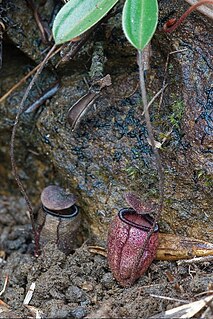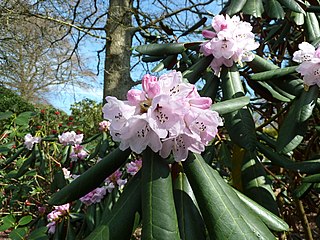
Rhododendron is a very large genus of about 1,024 species of woody plants in the heath family (Ericaceae). They can be either evergreen or deciduous. Most species are native to eastern Asia and the Himalayan region, but smaller numbers occur elsewhere in Asia, and in North America, Europe and Australia. It is the national flower of Nepal, the state flower of Washington and West Virginia in the United States, the state flower of Nagaland in India, the provincial flower of Jiangxi in China and the state tree of Sikkim and Uttarakhand in India. Most species have brightly colored flowers which bloom from late winter through to early summer.

Nepenthes sibuyanensis is a tropical pitcher plant endemic to Sibuyan Island in the Philippines, after which it is named.

Nepenthes argentii is a highland Nepenthes pitcher plant native to Mount Guiting-Guiting on Sibuyan Island in the Philippines. It is possibly the smallest species in the genus and does not appear to have a climbing stage.

Rhododendron catawbiense, with common names Catawba rosebay, Catawba rhododendron, mountain rosebay, purple ivy, purple laurel, purple rhododendron, red laurel, rosebay, rosebay laurel, is a species of Rhododendron native to the eastern United States, growing mainly in the southern Appalachian Mountains from Virginia south to northern Alabama.

Rhododendron maximum — its common names include great laurel, great rhododendron, rosebay rhododendron, American rhododendron and big rhododendron — is a species of Rhododendron native to the Appalachians of eastern North America, from Alabama north to coastal Nova Scotia.

Wildlife diversity is a notable feature of Nepal. Because of the variance in climate, from tropical to arctic, Nepal has a large variety of plants and animals. Wildlife tourism is also a major source of tourism in the country. There are some animal species which are unique to Nepal, such as the spiny babbler. Nepal is also host to many rhododendron species. The wildlife of Nepal includes its flora and fauna. Nepal has established numerous national parks and reserves in order to protect its diverse fauna. Nepal is a biodiversity hot spot with ecoregions broadly comprising the mountainous ecoregion, the savanna and grasslands ecoregion of the terai (foothills), and the Rara Lake ecoregion, which has many endemic species.
Rhododendron album is a species of plant in the family Ericaceae. It is endemic to Java in Indonesia. It is a vulnerable species threatened by habitat loss.

Rhododendron jucundum is a species of plant in the family Ericaceae. It is endemic to China. It is threatened by habitat loss.

Rhododendron kanehirai is a species of plant in the family Ericaceae. It was originally endemic to Taiwan. It has become extinct in the wild, though it still exists in cultivated form.
Rhododendron loerzingii is a species of plant in the family Ericaceae. It is endemic to Java in Indonesia. It is threatened by habitat loss.

Rhododendron rex (大王杜鹃), the king rhododendron, is a tree species, usually 5–8 m (16–26 ft) in height, in the family Ericaceae. It is found in China, India, and Myanmar, where it is threatened by habitat loss. The flowers are creamy-white, or pale yellow to pink, with a crimson basal blotch. The leaves are 17–27 cm in length and are covered on the underside with an indumentum that ranges in colour from greyish to rusty brown.
Rhododendron subansiriense is a species of flowering plant in the family Ericaceae, endemic to the Subansiri district of northeastern India. Growing to 14 m (46 ft) in the wild, it has dense trusses of red flowers spotted with purple.
Rhododendron wattii is a species of plant in the family Ericaceae. It is endemic to India.
Rhododendron wilhelminae is a species of plant in the family Ericaceae, endemic to Java in Indonesia. It is a critically endangered species threatened by habitat loss.
Rhododendron wrayi is a species of flowering plant in the family Ericaceae, endemic to Peninsular Malaysia.
Lyndley Alan Craven was a botanist who became the Principal Research Scientist of the Australian National Herbarium.

Rhododendron fulvum is a species of flowering plant in the heath family Ericaceae, native to northern Myanmar and China. In China, it is found in southwest Sichuan, southeast Xizang, and western Yunnan. It grows at altitudes of 2,700–4,400 m (8,900–14,400 ft). It is an evergreen shrub or small tree growing to 2–8 m (6.6–26.2 ft) in height, with leathery leaves that are oblanceolate to oblong-lanceolate or obovate, 8–20 by 3–7.5 cm in size. The undersides are felted with a striking cinnamon colour. The flowers, borne in trusses in spring, are loosely bell-shaped, pale rose pink, with a crimson basal blotch and sometimes red spots.
Psylliodes luridipennis, commonly known as the Lundy cabbage flea beetle or the bronze Lundy cabbage flea beetle, is a species of flea beetle endemic to the island of Lundy, where it lives and feeds upon the endemic Lundy cabbage. Along with the true weevil Ceutorhynchus contractus var. pallipes and an undescribed race of flea beetle Psylliodes napi, it is known only from the Lundy cabbage. The species was first recorded by Thomas Vernon Wollaston in the 1840s, and was named by the Austrian entomologist Franz Kutschera in 1864.

Rhododendron sinogrande (凸尖杜鹃) is a species of flowering plant in the family Ericaceae. It is commonly called the great Chinese rhododendron, and is native to alpine regions at 2,100–3,600 m (6,900–11,800 ft) in southeastern Xizang and western Yunnan in China and in northeastern Myanmar.

Kobuleti Strict Nature Reserve is a protected area in Kobuleti Municipality, Adjara region of Georgia along the Black Sea coast in the northern part of the resort town Kobuleti. Kobuleti Protected Areas were established in 1998 to preserve unique wetland ecosystems recognized by the Ramsar Convention. Because of these wetland ecosystems, ancient forests, and the high biodiversity found within the reserve, it was inscribed on the UNESCO World Heritage List as part of the Colchic Rainforests and Wetlands in 2021.












